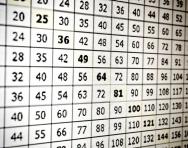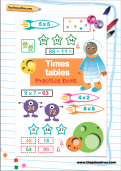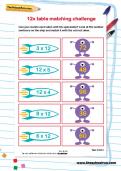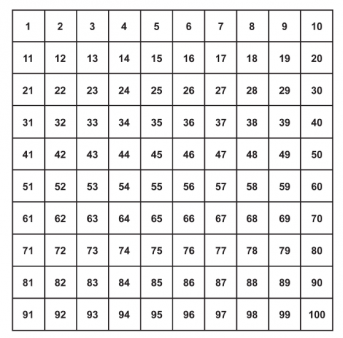I Want to Memorize Times Tables Again. Fastest Way?
Times tables: the best means to larn

Each multiplication table has its own pattern and poses a different challenge to learners. Instructor and educational consultant John Baldheaded offers practical strategies and ideas to aid your child learn each times table and boost their confidence with multiplication.
Times tables: why do we learn them?
Why learn times tables? Play a little game with your son or daughter, counting upwards to 20 and seeing how long information technology takes. You might like to use a lookout man with a seconds paw, or a stopwatch if your child likes such things. Then have them ask you two x 10. When you give them the answer, they'll see immediately why nosotros learn tables. It saves time. Early on maths starts with counting, and the way we organise information technology about certainly stems from our offset mathematical aid, our fingers. Arithmetics is an extension of counting – learning the most efficient ways of calculating allows usa to deal with larger numbers, and somewhen with much larger numbers, without the slow procedure of moving backwards and forwards, one number at a time.
In the longer term, as well as their obvious application to multiplication, we need tables for division. Partition calculations brainstorm with a large number and in effect take bites out of it, beginning with the biggest bite possible. Separate 36 by five, for example. Knowing our tables lets us take a big seize with teeth of 7 x v out of information technology, leaving 1 as a remainder. If nosotros don't know the tables, we need much more than complicated and time-consuming procedures to cutting the number into smaller pieces, with the result that partitioning is a large weakness in school arithmetic.


Get FREE Times Tables Resources
- Printable and interactive worksheets
- Practice workbook
- Games pack
Algebra also uses a slap-up deal of division and multiplication. Most of the numbers used in beginners' algebra are pocket-size, but knowing tables automatically – that is, without having to commencement at the beginning and count through each item – frees all our attention so that nosotros tin can focus on whatever problem we have to solve.
So, multiplication tables salve time and free upwardly brain space. They are liberators of the listen and a wonderful invention, probably past the Greek philosopher Pythagoras, whose name is nonetheless attached to them in most European languages. Pythagoras wrote them in the square format that many schools even so apply (a number square):

It is, though, worth going upward to 12 rather than 10: print a colour-coded multiplication square for your kid as a times tables visual aid. The 11 and 12 times tables are easy to learn in one case you lot know the others and lots of financial contracts involve monthly payments, and then that knowing the 12 times table lets us work out annual costs without difficulty. Learning these tables also helps children learn not to be afraid of larger numbers.
To chant or non to chant?
For a long time, and when I was at school, children learned tables past continuing upward each morning and reciting a full set out loud. No-one ever tested whether this was the best way to acquire tables, only it seemed to piece of work for most of the people nearly of the time, and is still some teachers' – and some maths directorate' – favourite method. Why does it work? Eric Kandel, who won the Nobel Prize in 2000 for his piece of work on memory, showed that repeated stimulus (for example, through repetition) enables encephalon cells to grow and make new connections.
My work with people who accept found learning tables tricky, though, has convinced me that initial connections have to be firmly established before this procedure can start, and that means making sure that children really know and understand the two times table.
Getting the foundations correct: the two times table
About children who have struggled with tables don't so much have a problem with adding 2 to a previous number – 2, four, six, viii is elementary enough to be used every bit a football game chant – as with losing their place. "Two twos are four, five twos are..." "Two twos are iv, six..." "Two twos are four, four twos are..." are just some of the examples I've heard. They involve either counting on from the concluding number a child has said, repeating information technology, or jumping straight to the adjacent reply.
On the other hand, getting the twos right establishes a design of understanding how one column of a tabular array moves upwardly i number at a time, and the other in multiples. So, if your kid is having trouble with tables, time taken to build confidence with the 2 times table will often be the key to learning the rest. And if they learn them easily, the pattern can be a springboard that will make tables pretty straightforward upwards to twelve times – and beyond, if they really find them fun.
Getting the all-time out of praise
We all love praise and most of united states don't love being criticised. Then, praise is about of import when learning tables.
My approach is ever to praise an improvement, including a fault that a child puts correct for him or herself. I don't praise trying, if trying leads to an error, but I don't criticise either – I will usually just echo the question in a neutral tone, or go back to an earlier betoken in a table that a child knows, and take it from at that place. Then I praise when the child gets the right respond, and accelerate the praise when they've really had to work to get something correct. Sometimes I use a "full praise argument", pointing out what they couldn't exercise concluding week and tin do this week, going on to explicate how this will help them to learn the next step. Information technology takes a bit of practice not to testify impatience when a child makes a error, specially if you are related to them – giving a child driving lessons is a archetype instance! – but information technology actually is worth learning to practice this, every bit information technology volition help you in all areas of learning as well every bit with tables.
The " um... times table"
Information technology's amend to hesitate and become something right, than to stab at it and get information technology wrong.A parent once described her daughter's efforts as the "um...times table" as she thought most each detail before answering. Even so, stopping to say "um" and count in the middle of a long multiplication sound is not a adept idea. Then – change the subject to something the kid is interested in and and then, without warning, inquire items from the table again. Electricity will course along the neural connections and your child will ordinarily brainstorm to get things right. If they're savvy, they'll realise what you're well-nigh to do, and accept the respond ready. Instantly. Curses! (A good technique for other areas of learning too, including spelling.)
Paired tables
In paired reading, child and parent read aloud together from a suitable text, and at a pace to suit the child. In one case the kid feels they can go on on their own, they tap the book or the table, and the parent stops. Once the child makes a error, parent simply joins in again, correctly reading the misread word (which the child must repeat) and conveying on with the child. In do, parent needs to go slowly enough for the child to proceed up, and you volition find the child looking closely at your face up for clues.
Awarding of the "paired reading" technique to learning tables (in other words, repeating tables out loud together) offers good practice in co-ordination, fluency and helping children non to switch between columns. Your kid might well relish doing this with both parents.
Times tables learning tools
Useful items to aid your help your kid with times tables at dwelling house include:
-
A stack of coins – at least a dozen each of 1p, 5p and 10p, and preferably ii dozen 2p, volition let you brand up a full fix of tables to 12x12 for the occasions when your kid might need to go dorsum and check by counting. No cost, beyond the time it takes to collect up the change.
-
A pack of cards – take out the aces and Kings, count Jack as 11 and Queen as 12, and you can practice the full range of tables by dealing your child two cards and asking them to multiply them.
-
A pack of blank cards (make them out of paper-thin or paper, or buy premade versions) These are infinitely versatile. You can write downward whatever items your child has bug with and make Pelmanism sets with questions and answers. (Write the questions and answers on different cards. Shuffle and turn the cards face down. The child has to turn over a card, and then turn over the matching card. Y'all tin start with a small number of sets and build up.) How many menu questions can your child answer correctly against the clock? Boys very much enjoy this, but so do almost girls.
-
Numicon – a organisation comprising a baseboard and coloured tiles of betwixt i and ten units. Many uses in early on maths, including building up tables through series of tiles. Not cheap, only I've sometimes found information technology makes illustrating an idea very easy, and the consistency of the tiles builds upwardly a sense of number, so that children think, say, in threes rather than just counting.
-
Times tables worksheets and printable games – there are loads to choose from on TheSchoolRun.
What websites and worksheets can't do is explicate how tables operate, or feed back to a child why they've made a mistake, and how to avert it next time. So, best to keep them for practice and speeding up after your child has learned a table.
For help and tips with specific times tables follow the links to more advice:
-
Tips and tricks for learning the two times table
-
Learning the 3 times tabular array: expert advice
-
The four times table step past footstep
-
The "easy" times tables: 5s, 10, 11s and 12s
-
The hardest multiplication table to learn: the 7 times table
-
The "tricky" times tables: 6s, 8s and 9s
Once your child has a a full fix of tables, they demand to do so that they are automatic by the fourth dimension they start secondary school. A light touch, coming dorsum to those that are difficult, volition assistance, just you should also ensure that your kid learns the standard methods of multiplication and division, so that they exercise not be come over-reliant on doubling and dividing by 10.
John Bald is an educator with forty years' experience in teaching literacy, languages and basic maths.
Times tables worksheets, games and more advice
For more information most all aspects of times tables learning and links to resources see our Times Tables hub and TheSchoolRun's Times Tables Learning Journey.
Source: https://www.theschoolrun.com/times-tables-best-ways-learn
0 Response to "I Want to Memorize Times Tables Again. Fastest Way?"
Post a Comment